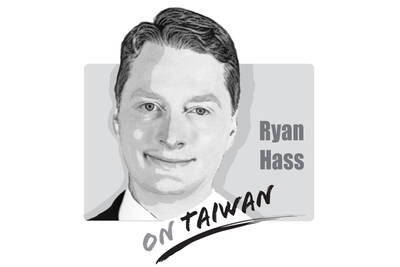Amid the worst cross-strait security crisis in 20 years, the Chinese State Council on Wednesday released a white paper titled The Taiwan Question and China’s Reunification in the New Era, an update to Taiwan white papers issued in 1993 and 2000.
The new white paper says that Taiwan is part of China and Beijing “will not renounce the use of force” to achieve unification, hailing the “one country, two systems” framework as the most inclusive solution to the situation, but not mentioning the so-called “1992 consensus.”
Later that day, Chinese Nationalist Party (KMT) Vice Chairman Andrew Hsia (夏立言) embarked with a delegation on a trip to China, despite having drawn fire from across Taiwan’s political spectrum, even from within his party. Defending the trip, the KMT said it has no political intentions because the delegation would not visit Beijing, but Hsia undermined the message by saying they would not reject meetings with Chinese politicians suggested by their hosts.
President Tsai Ing-wen (蔡英文) said the trip not only disappointed Taiwanese, but could send a wrong message to the international community. The visit also received a backlash from KMT councilors and younger party members, such as KMT New Taipei City councilor candidate Lu Chia-kai (呂家愷), who slammed the trip as “lacking legitimacy and good reason,” and calling Hsia the “black sheep of the party.”
With cross-strait tensions escalating, the KMT could not have chosen a worse time for the trip, which has aroused skepticism regarding its stance and inflicted damage to Taiwan’s image in the global community.
Hsia facilitated a landmark meeting between then-president Ma Ying-jeou (馬英九) and Chinese President Xi Jinping (習近平) in 2015, and his China visit might have a hidden agenda, despite the KMT’s denial. Past dealings show that everything turns political when it comes to exchanges with the Chinese Communist Party. Hsia’s visit — carried out on behalf of KMT Chairman Eric Chu (朱立倫) — is an attempt to butter the party’s bread on both sides. The KMT increasingly claims a “pro-US stance,” with Chu touting it during a US trip and on Facebook welcoming a Taiwan visit by US House of Representatives Speaker Nancy Pelosi, but it now sends Hsia to China to seek Beijing’s approval. Pandering to China, Chu ordered the visit vying for a position of “peacemaker” between Taipei and Beijing.
However, the KMT is disregarding the unfolding crisis and placing its selfish interests above Taiwan’s image in the global community. Hsia’s visit can be interpreted as kowtowing to Beijing, leaving the world confused about Taiwan’s position at a time when the nation is garnering increasing support from the global community and positioning itself as a sovereign country that is not subordinate to China.
The KMT is also disrespecting the efforts of the military, which is helping Taiwan safeguard its territory, democracy, and its people and their property.
While the Indo-Pacific region is ripe with anti-China sentiment — with the US, Japan and other nations condemning China’s military drills and saber-rattling — Beijing might claim that a friendly visit by the vice chairman of Taiwan’s largest opposition party showed that the world misunderstands the situation and that it is merely “protecting” Taiwan.
It takes two to tango. China’s unification tactic can only work when it has collaborators. Should Beijing try to invade Taiwan, messages sent by the KMT might give Taiwan’s allies second thoughts before sending help. With this unwise move, the KMT is undermining Taiwan’s image and creating further division in the party, likely sending its support ratings into a nosedive.

There has been much catastrophizing in Taiwan recently about America becoming more unreliable as a bulwark against Chinese pressure. Some of this has been sparked by debates in Washington about whether the United States should defend Taiwan in event of conflict. There also were understandable anxieties about whether President Trump would sacrifice Taiwan’s interests for a trade deal when he sat down with President Xi (習近平) in late October. On top of that, Taiwan’s opposition political leaders have sought to score political points by attacking the Lai (賴清德) administration for mishandling relations with the United States. Part of this budding anxiety
The diplomatic dispute between China and Japan over Japanese Prime Minister Sanae Takaichi’s comments in the Japanese Diet continues to escalate. In a letter to UN Secretary-General Antonio Guterres, China’s UN Ambassador Fu Cong (傅聰) wrote that, “if Japan dares to attempt an armed intervention in the cross-Strait situation, it would be an act of aggression.” There was no indication that Fu was aware of the irony implicit in the complaint. Until this point, Beijing had limited its remonstrations to diplomatic summonses and weaponization of economic levers, such as banning Japanese seafood imports, discouraging Chinese from traveling to Japan or issuing
On Nov. 8, newly elected Chinese Nationalist Party (KMT) Chairwoman Cheng Li-wun (鄭麗文) and Vice Chairman Chi Lin-len (季麟連) attended a memorial for White Terror era victims, during which convicted Chinese Communist Party (CCP) spies such as Wu Shi (吳石) were also honored. Cheng’s participation in the ceremony, which she said was part of her efforts to promote cross-strait reconciliation, has trapped herself and her party into the KMT’s dark past, and risks putting the party back on its old disastrous road. Wu, a lieutenant general who was the Ministry of National Defense’s deputy chief of the general staff, was recruited
The Food and Drug Administration (FDA) on Nov. 5 recalled more than 150,000 eggs found to contain three times the legal limit of the pesticide metabolite fipronil-sulfone. Nearly half of the 1,169 affected egg cartons, which had been distributed across 10 districts, had already been sold. Using the new traceability system, officials quickly urged the public to avoid consuming eggs with the traceability code “I47045,” while the remainder were successfully recalled. Changhua County’s Wenya Farm — the source of the tainted eggs — was fined NT$120,000, and the Ministry of Agriculture instructed the county’s Animal Disease Control Center to require that